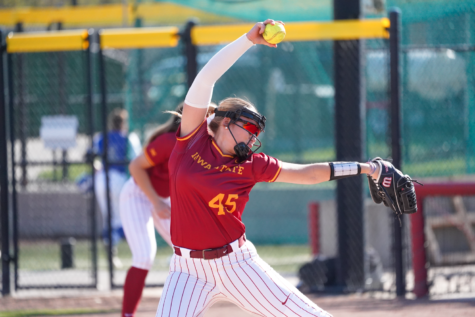New match play format could play to ISU men’s golf’s advantage at nationals
May 22, 2014
Collin Foster thought taking a summer class might not be a bad idea.
Barring him and his team making a historical trip to the NCAA finals, Foster’s summer would be free to devote to his studies and unwind from a long season as a member of the ISU men’s golf team.
Instead, Iowa State will compete in its first NCAA Division I Men’s Championship in 61 years at Prairie Dunes Country Club in Hutchinson, Kan. Now Foster will have to juggle the demands of being both a student and an athlete for one more week.
“I’ve got an accounting class, so I thought, ‘This will be great not having to worry about missing class.’ Then it turns out you’ll miss a week of a four-week class, which will be interesting,” Foster said. “But it’s a great problem to have.”
Entering the regional tournament, Iowa State was the ninth seed out of 15 teams that vied for a spot in the top five to advance.
“My message before regionals was that we’re just going to give it our best shot, we’re not going to be afraid to fail,” said ISU coach Andrew Tank. “We have nothing to lose.”
After advancing from regionals as an underdog with a “nothing to lose” mindset, Tank’s words will take on a literal meaning at nationals. According to the Golfweek/Sagarin rankings, Iowa State is the lowest-ranked team out of 30 in the field.
With nowhere to go but up at nationals, Tank and his team will look to keep the momentum going from their final round in Columbia that broke a school record and allowed them to cruise into a spot at nationals.
“We’ve done a good job stepping up. I think we take that as an advantage, being a lower ranked team in the field,” said freshman Ruben Sondjaja. “We feel like an underdog and we’ve performed well in those situations. We always seem to find a way to step up.”
With four starters, including Foster and Sondjaja, shooting under par in the final round to propel the Cyclones inside the top five, the magic number for Iowa State will be eight.
Eight of 30 teams will advance to a bracket-style match play finale after 54 holes of stroke play.
Implemented in 2009, the format is new to Division I golf. Some, including Tank, remain partial to the old 72-hole stroke play format that was in place when he won a national championship as the captain at Minnesota.
In the old, purely stroke play format, the strongest team was crowned champion. Now, the potential exists for a team that sneaks in to the top eight to catch fire during match play and upset a top-seeded team.
While Tank said he wants to wait until after the tournament to fully evaluate his thoughts on the format, he understands the benefits it brings to college golf.
He noted that though match play is a relatively foreign format in the collegiate game, it provides for good television and may offer an underdog team like his a better chance for success than with the old format.
“I think it’s a pretty cool opportunity for our team and it probably favors us if we can get into the match play,” Tank said. “We may not stack up head-to-head with all five players of the number one team in the country, but in match play you only have to win three matches, so it probably does favor a team like ours.”
Foster shared a similar sentiment to Tank’s. Given the breakout success of Iowa State’s postseason run and the volatility of match play, he is excited to see what the Cyclones will have up their sleeve for their final tournament.
“Obviously it’s a very strong field, but top eight is not like top two or top three; everyone’s got a shot at it,” Foster said. “Golf is a crazy game and it’s a hard course, so it’s very doable for us to make that top eight. Then, once you’re in the top eight, who knows?”
















